Application of Unconventional Seismic Attributes and Unsupervised Machine Learning for the Identification of Fault and Fracture Network
Abstract
:1. Introduction
2. Geological Settings
3. Methodology
3.1. Artificial Neural Network
3.2. Ant-Colony Optimization
3.3. Fault and Fracture Extraction
3.4. Seismic Conditioning
4. Shortlisting of Seismic Attributes
4.1. Dip Attributes
4.2. Curvature Attributes
4.3. Similarity
4.4. Thinned Fault Likelihood
4.5. Fracture Density
4.6. Fracture Proximity
5. Neural Network Computation
6. Ant-Tracking Computation
6.1. Attribute Conditioning
6.1.1. Structural Smoothing
6.1.2. Chaos
6.1.3. Variance
6.2. Ant-Tracking Result
6.3. Automatic Fault and Fracture Extraction Using ACO
7. Conclusions
- The structural features of the seismic volume were enhanced and sharpened using a DSMF, a DSDF, and a FEF. The FEF proved to be most effective in recognizing discontinuities.
- The novel technique of TFL was used for the generation of the likelihood, dip and the strike of the seismic cube. The generated TFL cube highlighted the maximum likelihood of the dips and the strikes of the fractures. The interconnected VCF ranked fracture bodies, automated fracture surfaces, and fracture sticks using TFL, and it delineated the orientations of fractures.
- The use of fracture density and fracture proximity are powerful tools in visualizing the high-density and maximum fracture activities regions that can be exploited for future drilling.
- The ANN–UVQ using multi-attribute computation identified the maximum and subtle fault, as well as the fractured locations and orientations, which will be beneficial for the field development of the study area.
- The ACO algorithm was effectively applied to study the dip, length, azimuth, and surface area of the fractures. The results of the ACO showed that there are more E–W oriented fractures than N–S fractures. The automatic extraction of fractures using ACO identified 607 subtle fracture patches. The dip azimuth of these fractures are clustered at SE–NW direction, the dip of most of the fractures lies between 16° to 32°, the fracture length lies between 200 and 500 m, and the surface area lies between 10,000 and 30,000 m2.
- The ANN–UVQ and ACO revealed an NNW–SSE oriented fault that has minor heave and throw.
- The adopted workflow in the study for the recognition of SSFs and fractures is automated, adaptive, time-saving, cost-saving, effective, innovative, and novel. The applied workflow is advanced and can be further utilized for the delineation of SSFs, large-scale faults, and fractures in any reservoir worldwide.
Author Contributions
Funding
Acknowledgments
Conflicts of Interest
References
- Clausen, O.R.; Korstgåd, J.A. Small-scale faulting as an indicator of deformation mechanism in the Tertiary sediments of the northern Danish Central Trough. J. Struct. Geol. 1993, 15, 1343–1357. [Google Scholar] [CrossRef]
- Jia, C. Characteristics of Chinese Petroleum Geology: Geological Features and Exploration Cases of Stratigraphic, Foreland and Deep Formation Traps; Springer Science & Business Media: Beijing, China, 2013. [Google Scholar]
- Yin, S.; Lv, D.; Ding, W. New method for assessing microfracture stress sensitivity in tight sandstone reservoirs based on acoustic experiments. Int. J. Geomech. 2018, 18, 04018008. [Google Scholar] [CrossRef]
- Boro, H.; Rosero, E.; Bertotti, G. Fracture-network analysis of the Latemar Platform (northern Italy): Integrating outcrop studies to constrain the hydraulic properties of fractures in reservoir models. Pet. Geosci. 2014, 20, 79–92. [Google Scholar] [CrossRef]
- Wennberg, O.P.; Casini, G.; Jonoud, S.; Peacock, D.C. The characteristics of open fractures in carbonate reservoirs and their impact on fluid flow: A discussion. Pet. Geosci. 2016, 22, 91–104. [Google Scholar] [CrossRef]
- Zeng, L. Microfracturing in the Upper Triassic Sichuan Basin tight-gas sandstones: Tectonic, overpressure, and diagenetic origins. AAPG Bull. 2010, 94, 1811–1825. [Google Scholar] [CrossRef]
- Zhou, Y.; Ji, Y.; Zhang, S.; Wan, L. Controls on reservoir quality of Lower Cretaceous tight sandstones in the Laiyang Sag, Jiaolai Basin, Eastern China: Integrated sedimentologic, diagenetic and microfracturing data. Mar. Pet. Geol. 2016, 76, 26–50. [Google Scholar] [CrossRef]
- Zhang, M.-L.; Bao, Y.; Zhang, S.-Q.; Liu, G.-Z. A Recognition Technology of Low Order Faults and Relative Application. Sci. Technol. Eng. 2011, 11, 7790–7901. [Google Scholar]
- Ameen, M.S.; Hailwood, E.A. A new technology for the characterization of microfractured reservoirs (test case: Unayzah reservoir, Wudayhi field, Saudi Arabia). AAPG Bull. 2008, 92, 31–52. [Google Scholar] [CrossRef]
- Peace, A.; McCaffrey, K.; Imber, J.; van Hunen, J.; Hobbs, R.; Wilson, R. The role of pre-existing structures during rifting, continental breakup and transform system development, offshore West Greenland. Basin Res. 2018, 30, 373–394. [Google Scholar] [CrossRef] [Green Version]
- Basir, H.M.; Javaherian, A.; Yaraki, M.T. Multi-attribute ant-tracking and neural network for fault detection: A case study of an Iranian oilfield. J. Geophys. Eng. 2013, 10, 015009. [Google Scholar] [CrossRef]
- Baytok, S.; Pranter, M.J. Fault and fracture distribution within a tight-gas sandstone reservoir: Mesaverde Group, Mamm Creek Field, Piceance Basin, Colorado, USA. Pet. Geosci. 2013, 19, 203–222. [Google Scholar] [CrossRef]
- Riaz, M.S.; Bin, S.; Naeem, S.; Kai, W.; Xie, Z.; Gilani, S.M.M.; Ashraf, U. Over 100 years of faults interaction, stress accumulation, and creeping implications, on Chaman Fault System, Pakistan. Int. J. Earth Sci. 2019, 108, 1351–1359. [Google Scholar] [CrossRef]
- Chenghao, L.; Liquan, G.; Wei, Z.; Fa, Y. Fine interpretation of mine geological structure through ant tracking technology. Coal Geol. China 2013, 25, 55–59. [Google Scholar]
- Hu, J.L.; Kang, Z.H.; Yuan, L.L. Automatic fracture identification using ant tracking in Tahe oilfield. Adv. Mater. Res. 2014, 962, 556–559. [Google Scholar]
- Jiang, X.; Li, X.; Li, X.; Wu, S.; Liu, N.; Liu, L. Application of ant tracking technology in small fault identification [J]. Tuha Oil Gas 2012, 17, 323–325. [Google Scholar]
- Zhou, W.; Yin, T.; Zhang, Y. Application of ant tracking technology to fracture prediction: A case study from Xiagou formation in Qingxi Oilfield. Lithol Reserv 2015, 27, 111–118. [Google Scholar]
- Cohen, I.; Coult, N.; Vassiliou, A.A. Detection and extraction of fault surfaces in 3D seismic data. Geophysics 2006, 71, P21–P27. [Google Scholar] [CrossRef] [Green Version]
- Di, H.; Gao, D. 3D seismic flexure analysis for subsurface fault detection and fracture characterization. Pure Appl. Geophys. 2017, 174, 747–761. [Google Scholar] [CrossRef]
- Iacopini, D.; Butler, R.; Purves, S.; McArdle, N.; De Freslon, N. Exploring the seismic expression of fault zones in 3D seismic volumes. J. Struct. Geol. 2016, 89, 54–73. [Google Scholar] [CrossRef] [Green Version]
- Marfurt, K.J.; Alves, T.M. Pitfalls and limitations in seismic attribute interpretation of tectonic features. Interpretation 2015, 3, SB5–SB15. [Google Scholar] [CrossRef]
- Tingdahl, K.M.; de Groot, P.F. Post-stack dip-and azimuth processing. J. Seism. Explor. 2003, 12, 113–126. [Google Scholar]
- Chopra, S.; Marfurt, K.J. Volumetric curvature attributes for fault/fracture characterization. First Break 2007, 25, 35–46. [Google Scholar] [CrossRef] [Green Version]
- Dee, S.; Yielding, G.; Freeman, B.; Healy, D.; Kusznir, N.; Grant, N.; Ellis, P. Elastic dislocation modelling for prediction of small-scale fault and fracture network characteristics. Geol. Soc. Lond. Spec. Publ. 2007, 270, 139–155. [Google Scholar] [CrossRef] [Green Version]
- Al-Dossary, S.; Marfurt, K.J. 3D volumetric multispectral estimates of reflector curvature and rotation. Geophysics 2006, 71, P41–P51. [Google Scholar] [CrossRef]
- Bravo, L.; Aldana, M. Volume curvature attributes to identify subtle faults and fractures in carbonate reservoirs: Cimarrona Formation, Middle Magdalena Valley Basin, Colombia. In Proceedings of the 2010 SEG Annual Meeting, Denver, CO, USA, 17–22 October 2010; Society of Exploration Geophysicists: Denver, CO, USA, 2010; pp. 2231–2235. [Google Scholar]
- Hart, B.S.; Pearson, R.; Rawling, G.C. 3-D seismic horizon-based approaches to fracture-swarm sweet spot definition in tight-gas reservoirs. Lead. Edge 2002, 21, 28–35. [Google Scholar] [CrossRef]
- Roberts, A. Curvature attributes and their application to 3D interpreted horizons. First Break 2001, 19, 85–100. [Google Scholar] [CrossRef]
- Bahorich, M.; Farmer, S. 3D seismic discontinuity for faults and stratigraphic features: The coherence cube. Lead. Edge 1995, 14, 1053–1058. [Google Scholar] [CrossRef]
- Anees, A.; Shi, W.; Ashraf, U.; Xu, Q. Channel identification using 3D seismic attributes and well logging in lower Shihezi Formation of Hangjinqi area, northern Ordos Basin, China. J. Appl. Geophys. 2019, 163, 139–150. [Google Scholar] [CrossRef]
- Dalley, R.; GEVERS, E.A.; Stampfli, G.; Davies, D.; Gastaldi, C. Die and azimuth displays for 3D seismic interpretation. First Break (Print) 1989, 7, 86–95. [Google Scholar]
- Nasseri, A.; Mohammadzadeh, M.J.; Tabatabaei Raeisi, S.H. Fracture enhancement based on artificial ants and fuzzy c-means clustering (FCMC) in Dezful Embayment of Iran. J. Geophys. Eng. 2015, 12, 227–241. [Google Scholar] [CrossRef]
- Randen, T.; Pedersen, S.I.; Sønneland, L. Automatic extraction of fault surfaces from three-dimensional seismic data. In Proceedings of the 2001 SEG Annual Meeting, San Antonio, TX, USA, 9–14 September 2001; Society of Exploration Geophysicists: San Antonio, TX, USA, 2001; pp. 551–554. [Google Scholar]
- Van Bemmel, P.P.; Pepper, R.E. U.S. Seismic Signal Processing Method and Apparatus for Generating a Cube of Variance Values. U.S. Patent No. 6,151,555, 21 November 2000. [Google Scholar]
- Hale, D. Methods to compute fault images, extract fault surfaces, and estimate fault throws from 3D seismic images. Geophysics 2013, 78, O33–O43. [Google Scholar] [CrossRef]
- Wu, X.; Hale, D. Automatically interpreting all faults, unconformities, and horizons from 3D seismic images. Interpretation 2016, 4, T227–T237. [Google Scholar] [CrossRef] [Green Version]
- Al-Anazi, A.; Babadagli, T. Automatic fracture density update using smart well data and artificial neural networks. Comput. Geosci. 2010, 36, 335–347. [Google Scholar] [CrossRef]
- Caers, J. Petroleum Geostatistics; Society of Petroleum Engineers: Richardson, TX, USA, 2005. [Google Scholar]
- Martinez-Torres, L.P. Characterization of Naturally Fractured Reservoirs from Conventional Well Logs; University of Oklahoma: Norman, OK, USA, 2002. [Google Scholar]
- Tokhmchi, B.; Memarian, H.; Rezaee, M.R. Estimation of the fracture density in fractured zones using petrophysical logs. J. Pet. Sci. Eng. 2010, 72, 206–213. [Google Scholar] [CrossRef]
- Zazoun, R.S. Fracture density estimation from core and conventional well logs data using artificial neural networks: The Cambro-Ordovician reservoir of Mesdar oil field, Algeria. J. Afr. Earth Sci. 2013, 83, 55–73. [Google Scholar] [CrossRef]
- Zhou, F.; Allinson, G.; Wang, J.; Sun, Q.; Xiong, D.; Cinar, Y. Stochastic modelling of coalbed methane resources: A case study in Southeast Qinshui Basin, China. Int. J. Coal Geol. 2012, 99, 16–26. [Google Scholar] [CrossRef]
- Jaglan, H.; Qayyum, F.; Hélène, H. Unconventional seismic attributes for fracture characterization. First Break 2015, 33, 101–109. [Google Scholar]
- Kumar, P.C.; Mandal, A. Enhancement of fault interpretation using multi-attribute analysis and artificial neural network (ANN) approach: A case study from Taranaki Basin, New Zealand. Explor. Geophys. 2018, 49, 409–424. [Google Scholar] [CrossRef]
- Ligtenberg, J.; Wansink, A. Neural network prediction of permeability in the El Garia formation, Ashtart Oilfield, offshore Tunisia. In Developments in Petroleum Science; Elsevier: Amsterdam, The Netherlands, 2003; Volume 51, pp. 397–411. [Google Scholar]
- Singh, D.; Kumar, P.C.; Sain, K. Interpretation of gas chimney from seismic data using artificial neural network: A study from Maari 3D prospect in the Taranaki basin, New Zealand. J. Nat. Gas Sci. Eng. 2016, 36, 339–357. [Google Scholar] [CrossRef]
- Smith, T.; Treitel, S. Self-organizing artificial neural nets for automatic anomaly identification. In Proceedings of the 2010 SEG Annual Meeting, Denver, CO, USA, 17–22 October 2010; Society of Exploration Geophysicists: Denver, CO, USA, 2010; pp. 1403–1407. [Google Scholar]
- Tingdahl, K.M.; De Rooij, M. Semi-automatic detection of faults in 3D seismic data. Geophys. Prospect. 2005, 53, 533–542. [Google Scholar] [CrossRef]
- Zheng, Z.H.; Kavousi, P.; Di, H.B. Multi-attributes and neural network-based fault detection in 3D seismic interpretation. Adv. Mater. Res. 2014, 838, 1497–1502. [Google Scholar]
- Nikravesh, M. Soft computing-based computational intelligent for reservoir characterization. Expert Syst. Appl. 2004, 26, 19–38. [Google Scholar] [CrossRef]
- Ngeri, A.; Tamunobereton-Ari, I.; Amakiri, A. Ant-tracker attributes: An effective approach to enhancing fault identification and interpretation. J. Vlsi Signal Process. 2015, 5, 67–73. [Google Scholar]
- Silva, C.C.; Marcolino, C.S.; Lima, F.D. Automatic fault extraction using ant tracking algorithm in the Marlim South Field, Campos Basin. In Proceedings of the 9th International Congress of the Brazilian Geophysical Society, Salvador, Brazil, 11–14 September 2005; Society of Exploration Geophysicists: Houstan, TX, USA, 2005; pp. 857–860. [Google Scholar]
- Jun, S. Application of ant tracking technology in small fault interpretation. J. Oil Gas Technol. 2009, 31, 257–258. [Google Scholar]
- Noha, F.; Zoback, M. Utilizing Ant-tracking to Identify Slowly Slipping Faults in the Barnett Shale. In Proceedings of the Unconventional Resources Technology Conference, Denver, CO, USA, 25–27 August 2014. [Google Scholar]
- Yang, R.; Li, Y.; Pang, H.; Qiu, N.; Jie, M.; Ma, Y.; Huo, C.; Liu, W.; Wang, F. Prediction technology of micro fractures by occurrence-controlled ant body and its application [J]. Coal Geol. Explor. 2013, 2, 631–644. [Google Scholar]
- Shujuan, Z.; Yanbin, W.; Xingru, L. Application of ant tracking technology in fracture prediction of carbonate buried⁃ hill reservoir. Fault Block Oil Gas Field 2011, 18, 51–54. [Google Scholar]
- Berger, A.; Gier, S.; Krois, P. Porosity-preserving chlorite cements in shallow-marine volcaniclastic sandstones: Evidence from Cretaceous sandstones of the Sawan gas field, Pakistan. AAPG Bull. 2009, 93, 595–615. [Google Scholar] [CrossRef] [Green Version]
- Qiang, Z.; Yasin, Q.; Golsanami, N.; Du, Q. Prediction of Reservoir Quality from Log-Core and Seismic Inversion Analysis with an Artificial Neural Network: A Case Study from the Sawan Gas Field, Pakistan. Energies 2020, 13, 486. [Google Scholar] [CrossRef] [Green Version]
- Afzal, J.; Kuffner, T.; Rahman, A.; Ibrahim, M. Seismic and Well-log Based Sequence Stratigraphy of The Early Cretaceous, Lower Goru “C” Sand of The Sawan Gas Field, Middle Indus Platform, Pakistan. In Proceedings of the Society of Petroleum Engineers (SPE)/Pakistan Association of Petroleum Geoscientists (PAPG) Annual Technical Conference, Islamabad, Pakistan, 17–18 November 2014. [Google Scholar]
- Wandrey, C.J.; Law, B.; Shah, H.A. Patala-Nammal Composite Total Petroleum System, Kohat-Potwar Geologic Province, Pakistan; US Department of the Interior, US Geological Survey Reston: Denver, CO, USA, 2004.
- Abbas, S.; Mirza, K.; Arif, S. Lower Goru Formation-3D modeling and petrophysical interpretation of Sawan gas field, Lower Indus Basin, Pakistan. Nucleus 2015, 52, 138–145. [Google Scholar]
- Balakrishnan, T.S. Role of Geophysics in the Study of Geology and Tectonics. Geophysical Case Histories of India; Association of Exploration Geophysics: New Delhi, India, 1977; Volume 35, pp. 229–250. [Google Scholar]
- Farah, A.; Mirza, M.A.; Ahmad, M.A.; Butt, M.H. Gravity field of the buried shield in the Punjab Plain, Pakistan. Geol. Soc. Am. Bull. 1977, 88, 1147–1155. [Google Scholar] [CrossRef]
- Seeber, L. Seismotectonics of Pakistan: A review of results from network data and implications for the Central Himalaya. Geol. Bull. Univ Peshawar. 1980, 13, 151–168. [Google Scholar]
- Azeem, T.; Chun, W.Y.; Khalid, P.; Ehsan, M.I.; Rehman, F.; Naseem, A.A. Sweetness analysis of Lower Goru sandstone intervals of the Cretaceous age, Sawan gas field, Pakistan. Epis. J. Int. Geosci. 2018, 41, 235–247. [Google Scholar] [CrossRef]
- Kazmi, A.H.; Jan, M.Q. Geology and Tectonics of Pakistan; Graphic publishers: Karachi, Pakistan, 1997. [Google Scholar]
- Quadri, V.N.; Shuaib, S.M. Geology and hydrocarbon prospects of Pakistan’s offshore Indus basin. Oil Gas J. 1987, 85, 65–67. [Google Scholar]
- Ahmad, N.; Fink, P.; Sturrock, S.; Mahmood, T.; Ibrahim, M. Sequence stratigraphy as predictive tool in lower goru fairway, lower and middle Indus platform, Pakistan. In Proceedings of the PAPG ATC, Islamabad, Pakistan, 8–9 October 2004; pp. 85–104. [Google Scholar]
- Ashraf, U.; Zhu, P.; Yasin, Q.; Anees, A.; Imraz, M.; Mangi, H.N.; Shakeel, S. Classification of reservoir facies using well log and 3D seismic attributes for prospect evaluation and field development: A case study of Sawan gas field, Pakistan. J. Pet. Sci. Eng. 2019, 175, 338–351. [Google Scholar] [CrossRef]
- Ja’fari, A.; Kadkhodaie-Ilkhchi, A.; Sharghi, Y.; Ghanavati, K. Fracture density estimation from petrophysical log data using the adaptive neuro-fuzzy inference system. J. Geophys. Eng. 2012, 9, 105–114. [Google Scholar] [CrossRef]
- Barnes, A.E. Weighted average seismic attributesAverage Seismic Attributes. Geophysics 2000, 65, 275–285. [Google Scholar] [CrossRef]
- Derigo, M.; Stutzle, T. Ant Colony Optimization; The Mit Press: Cambridge, MA, USA, 2004. [Google Scholar]
- Gibson, D.; Spann, M.; Turner, J. Automatic Fault Detection for 3D Seismic Data. In Proceedings of the Seventh International Conference on Digital Image Computing: Techniques and Applications, Sydney, Australia, 10–12 December 2003; pp. 821–830. [Google Scholar]
- Ohmi, K.; Sapkota, A.; Panday, S.P. Applicability of Ant Colony Optimization in particle tracking velocimetry. In Proceedings of the 14th International Symposium on Applications of Laser Techniques to Fluid Mechanics, Lisbon, Portugal, 7–10 July 2008. [Google Scholar]
- Bonabeau, E.; Théraulaz, G. Swarm smarts. Sci. Am. 2000, 282, 72–79. [Google Scholar] [CrossRef]
- Skov, T.; Pedersen, S.; Valen, T.; Fayemendy, P.; Grønlie, A.; Hansen, J.; Hetlelid, A.; Iversen, T.; Randen, T.; Sønneland, L. Fault system analysis using a new interpretation paradigm. In Proceedings of the 65th EAGE Conference & Exhibition, Stavanger, Norway, 2–5 June 2003. [Google Scholar]
- Fang, J.; Zhou, F.; Tang, Z. Discrete fracture network modelling in a naturally fractured carbonate reservoir in the Jingbei oilfield, China. Energies 2017, 10, 183. [Google Scholar] [CrossRef] [Green Version]
- Zhao, J.; Sun, S.Z. Automatic fault extraction using a modified ant-colony algorithm. J. Geophys. Eng. 2013, 10, 025009. [Google Scholar] [CrossRef]
- Mandal, A.; Srivastava, E. Enhanced structural interpretation from 3D seismic data using hybrid attributes: New insights into fault visualization and displacement in Cretaceous formations of the Scotian Basin, offshore Nova Scotia. Mar. Pet. Geol. 2018, 89, 464–478. [Google Scholar] [CrossRef]
- Höcker, C.; Fehmers, G. Fast structural interpretation with structure-oriented filtering. Lead. Edge 2002, 21, 238–243. [Google Scholar] [CrossRef]
- Randen, T.; Monsen, E.; Signer, C.; Abrahamsen, A.; Hansen, J.O.; Sæter, T.; Schlaf, J. Three-dimensional texture attributes for seismic data analysis. In Proceedings of the 2000 SEG Annual Meeting, Calgary, AB, Canada, 6–11 August 2000; Society of Exploration Geophysicists: Calgary, AB, Canada, 2000; pp. 668–671. [Google Scholar]
- Marfurt, K.J. Robust estimates of 3D reflector dip and azimuth. Geophysics 2006, 71, P29–P40. [Google Scholar] [CrossRef]
- Mai, H.T.; Marfurt, K.J.; Chávez-Pérez, S. Coherence and volumetric curvatures and their spatial relationship to faults and folds, an example from Chicontepec basin, Mexico. In Proceedings of the 2009 SEG Annual Meeting, Houston, TX, USA, 25–30 October 2009; Society of Exploration Geophysicists: Houston, TX, USA, 2009; pp. 1063–1067. [Google Scholar]
- Marfurt, K.J.; Kirlin, R.L.; Farmer, S.L.; Bahorich, M.S. 3-D seismic attributes using a semblance-based coherency algorithm. Geophysics 1998, 63, 1150–1165. [Google Scholar] [CrossRef] [Green Version]
- Darmawan, F.H.; Kurniawan, T.; Bakar, A.B.A.; Kee, T.H.; Mangsor-Mansor, N.H.B.; Nasifi, W.B.; Condronegoro, R.; Syafriya, A.; Shen, L.C.; Dominguez, J. Integrated Seismic Attributes Analysis of Naturally Fractured Basement Reservoir: An Approach to Define Sweet Spot for Optimum Well Location and Trajectory. In Proceedings of the Forty-First Annual Convention & Exhibition, Indonesia, 21–23 May 2017. [Google Scholar]
- Pigott, J.D.; Kang, M.-H.; Han, H.-C. First order seismic attributes for clastic seismic facies interpretation: Examples from the East China Sea. J. Asian Earth Sci. 2013, 66, 34–54. [Google Scholar] [CrossRef]
- Pedersen, S.I.; Randen, T.; Sonneland, L.; Steen, Ø. Automatic fault extraction using artificial ants. In Mathematical Methods and Modelling in Hydrocarbon Exploration and Production; Springer: Berlin/Heidelberg, Germany, 2005; pp. 107–116. [Google Scholar]
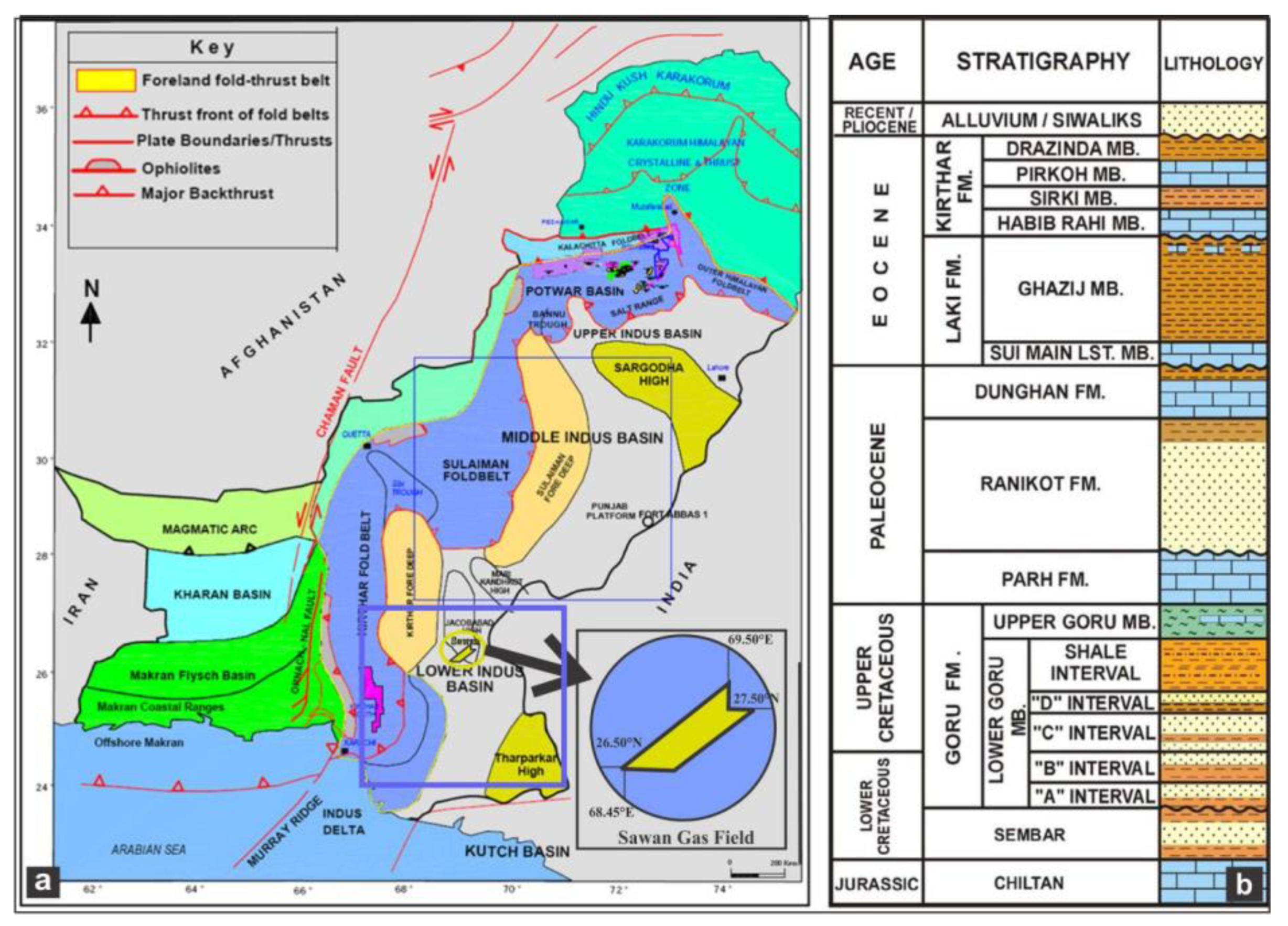
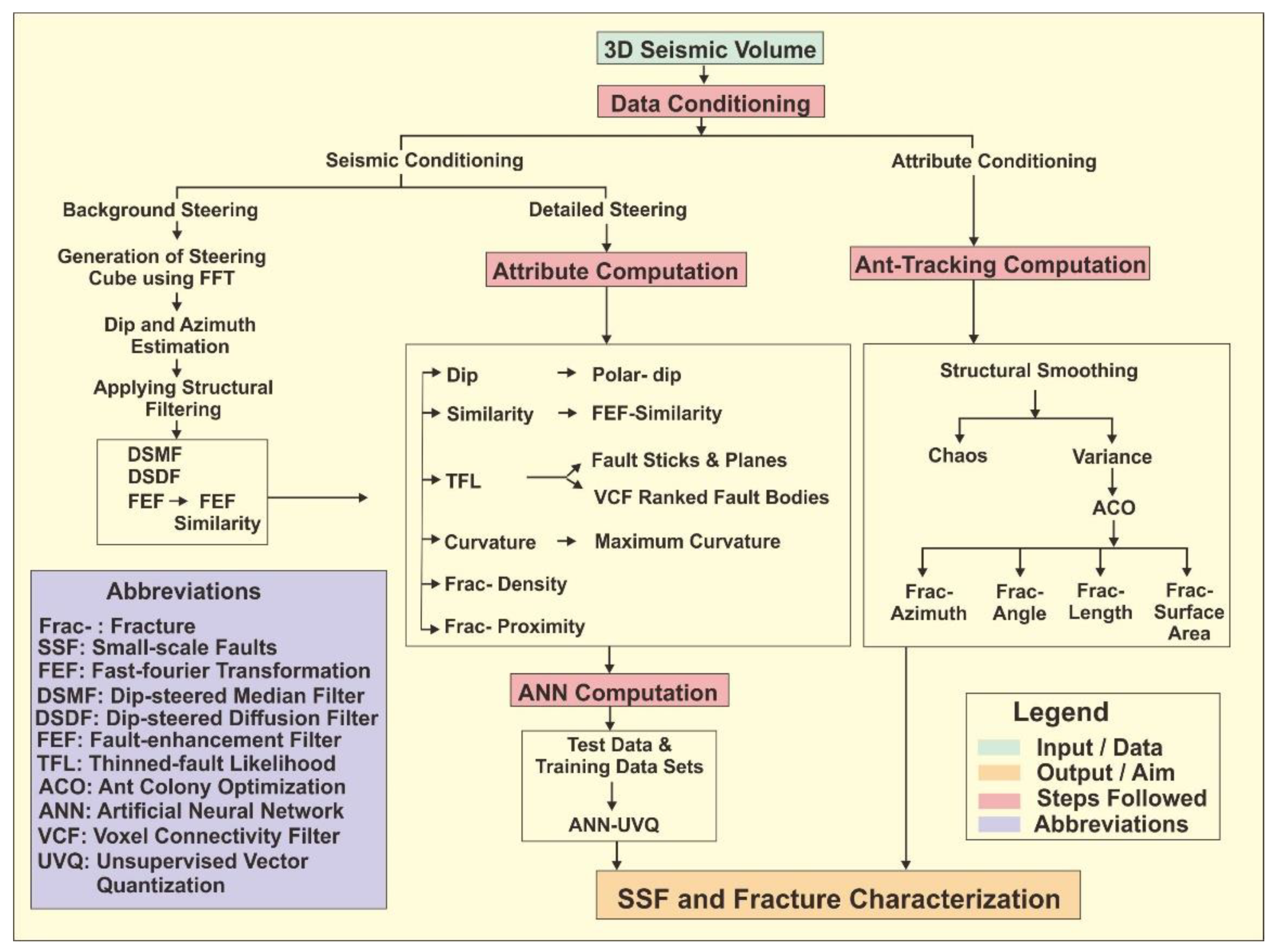
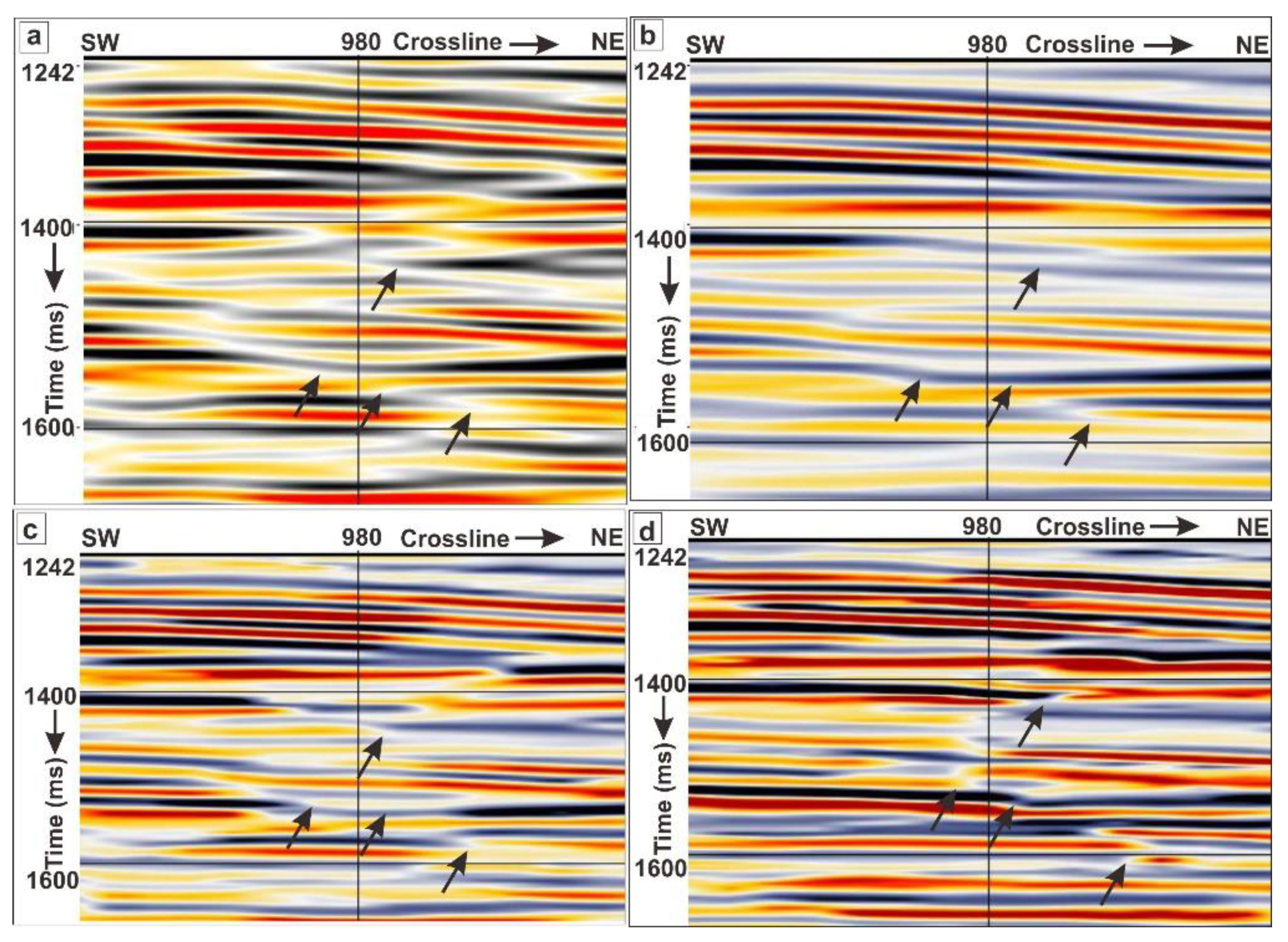

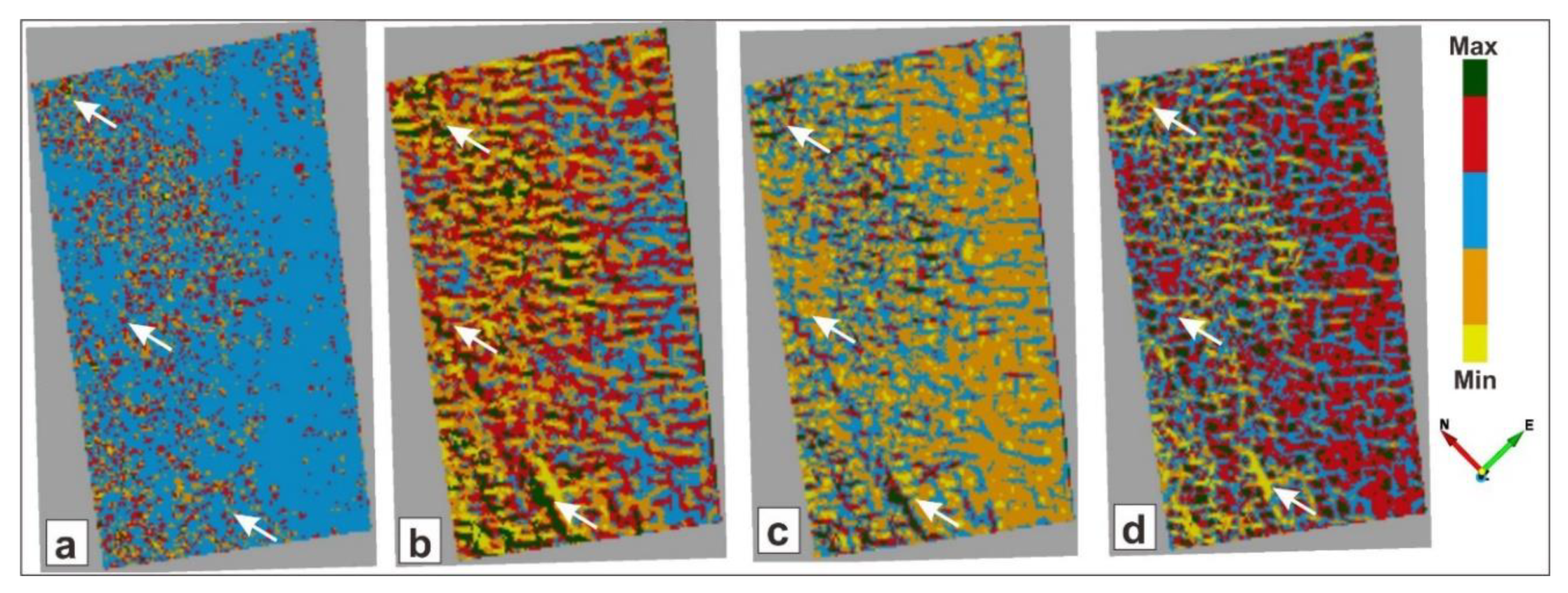

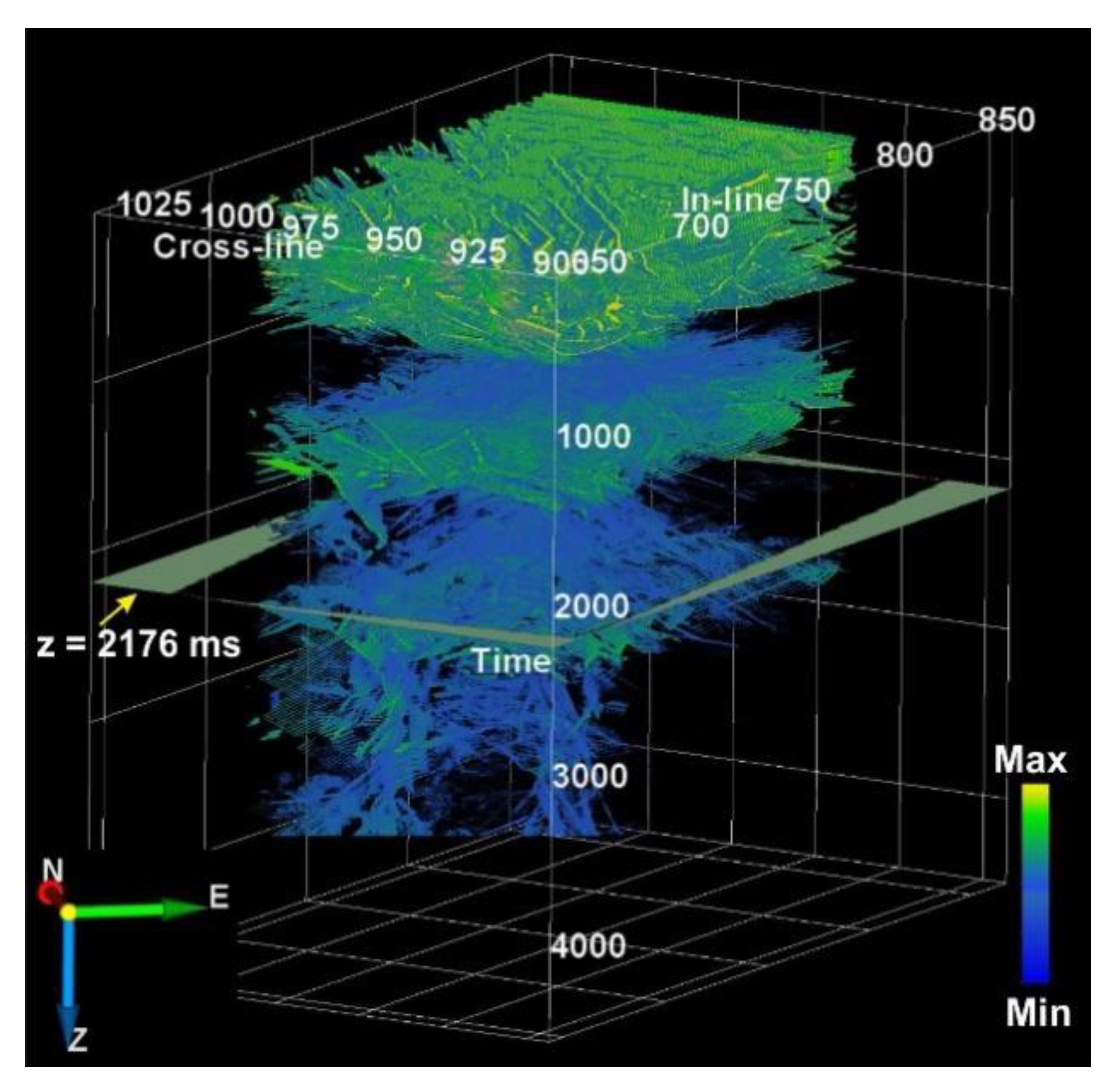
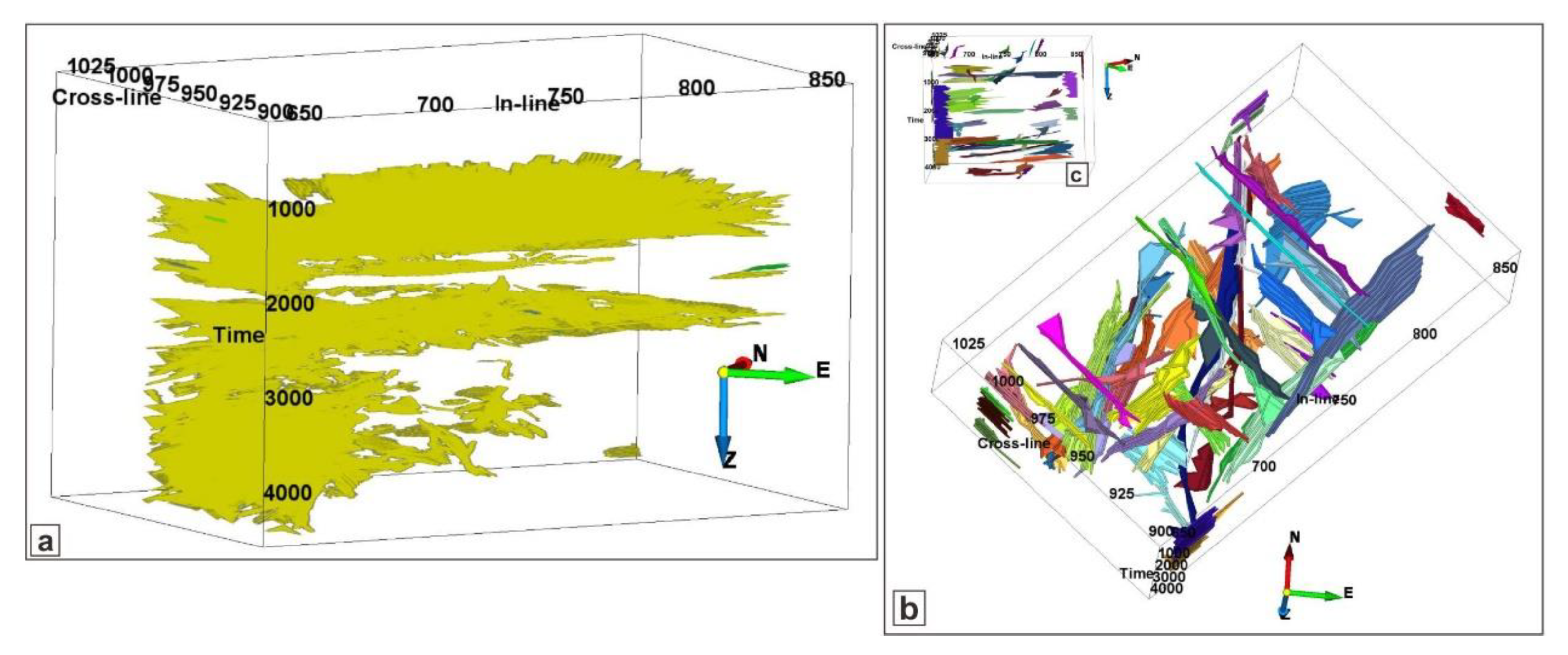


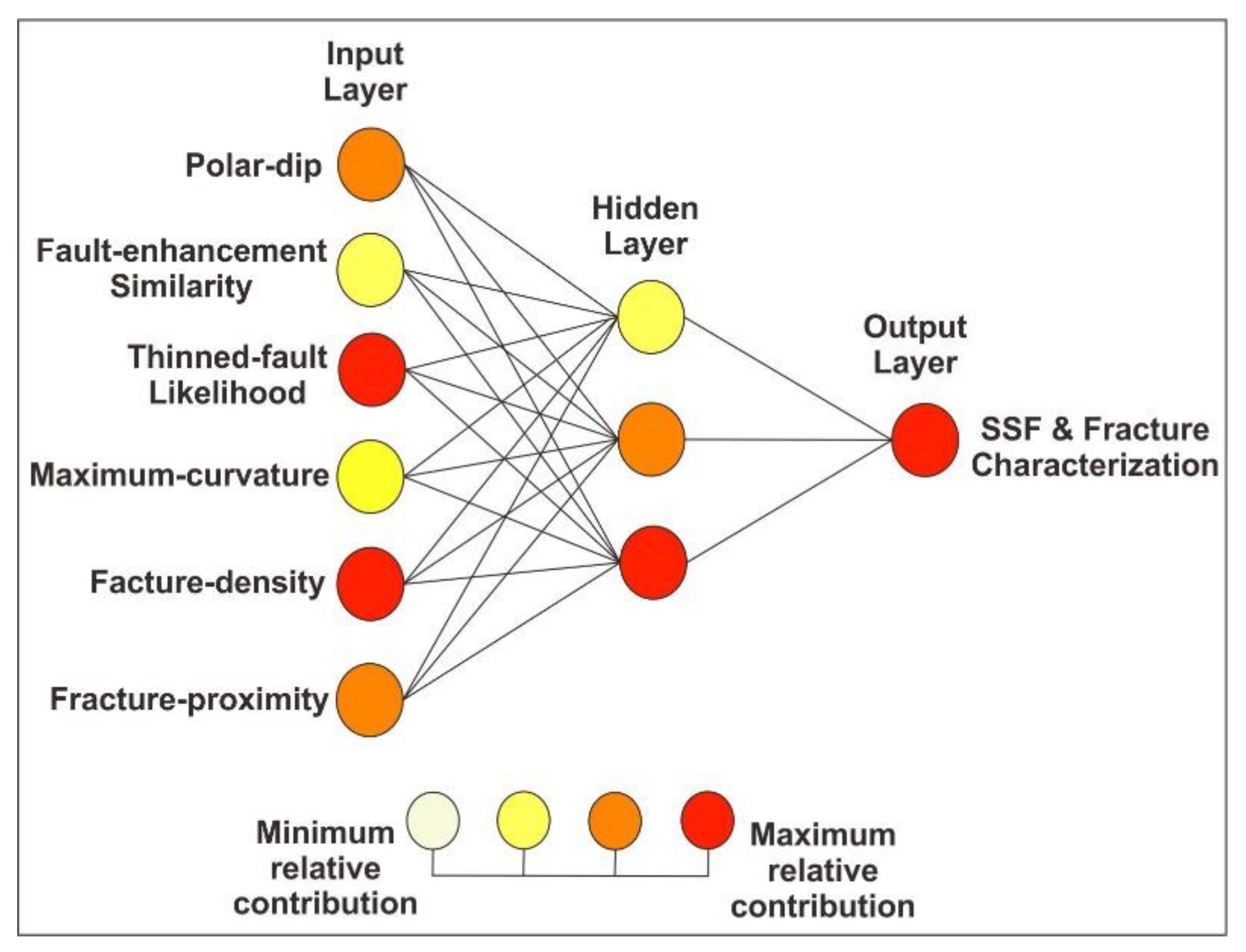
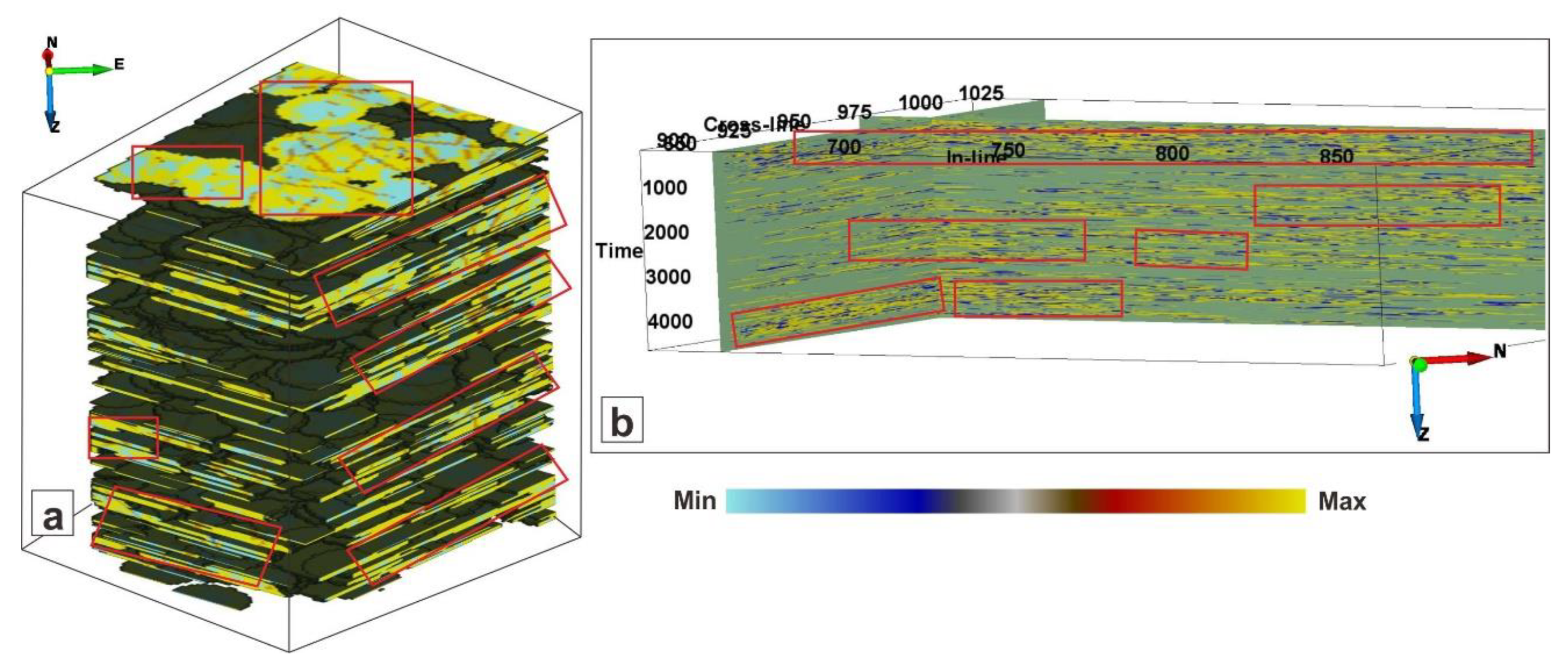
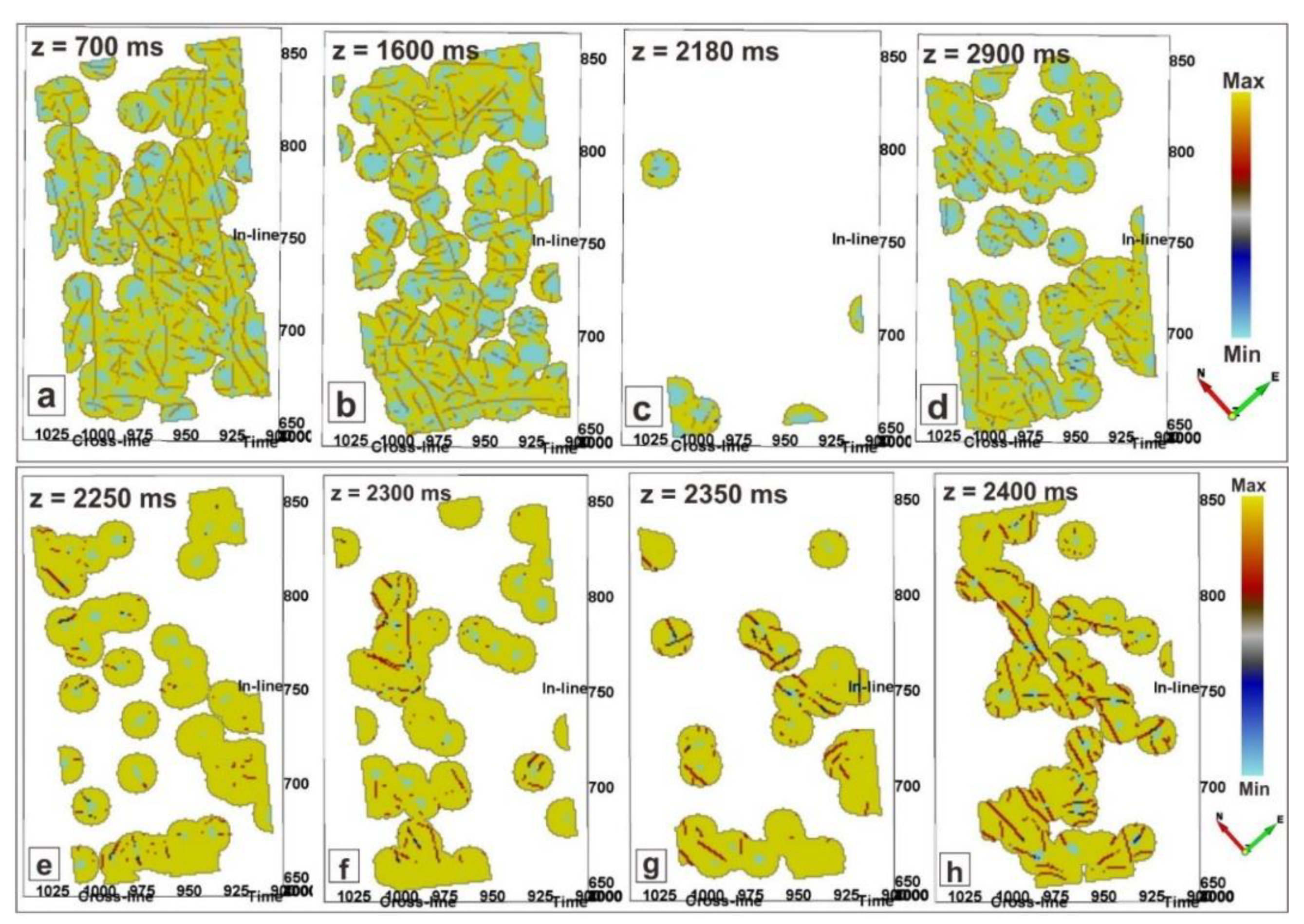

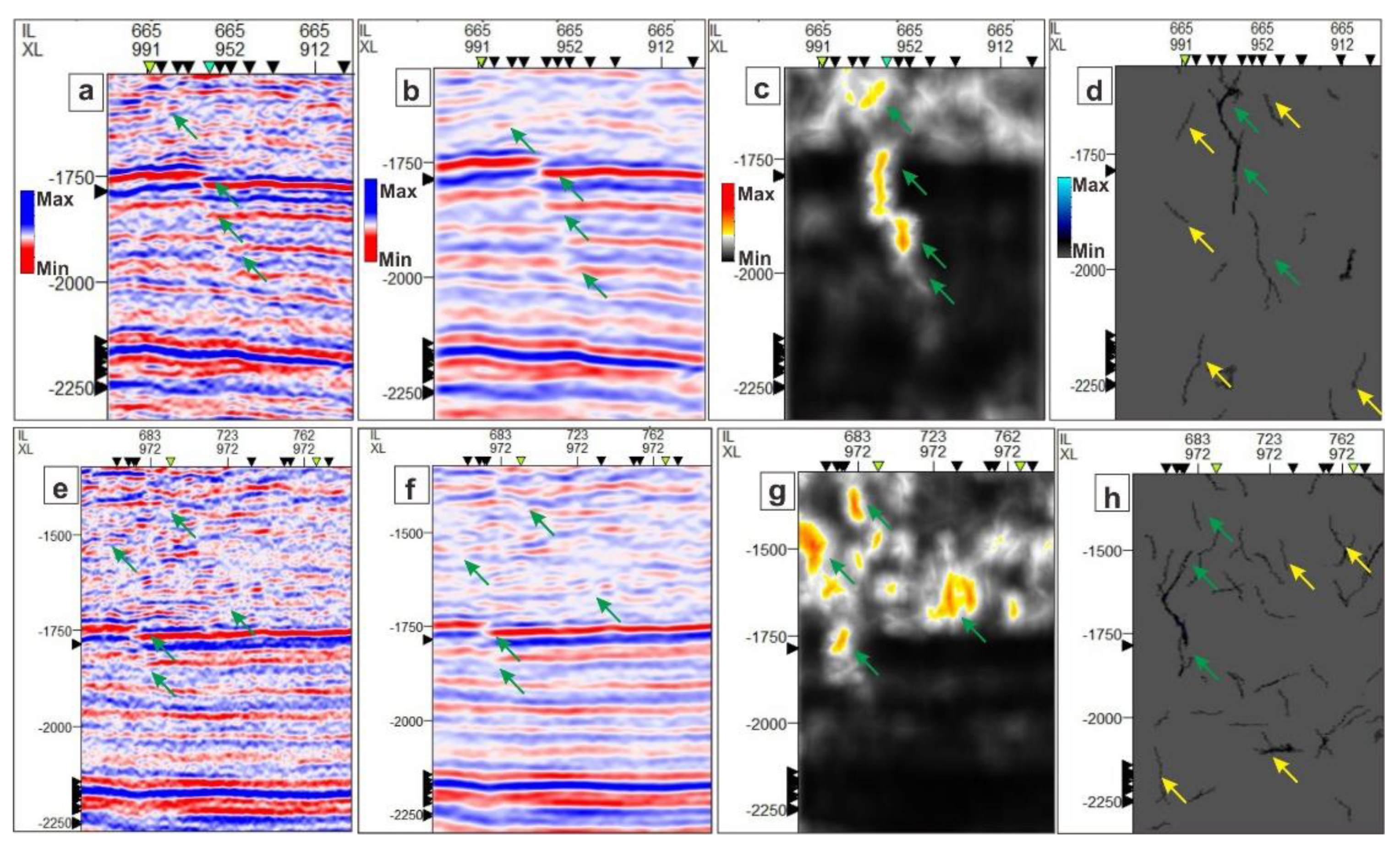
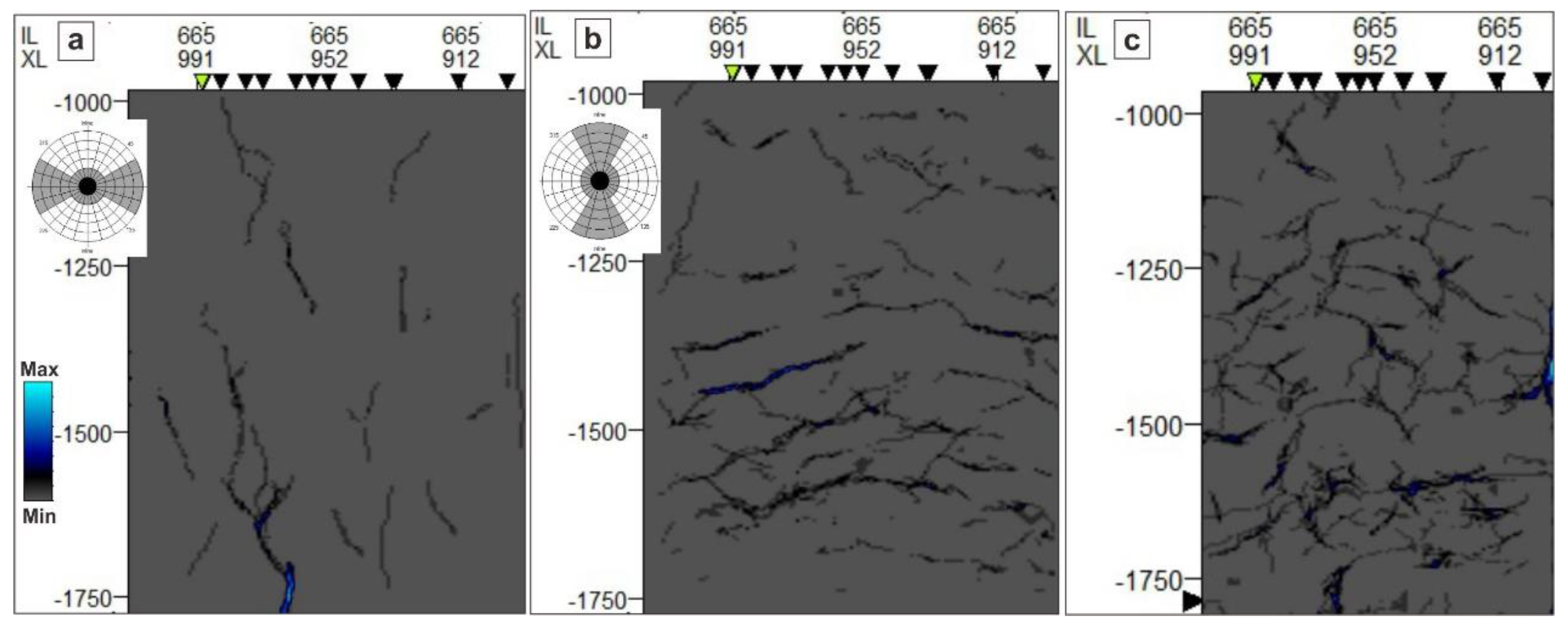
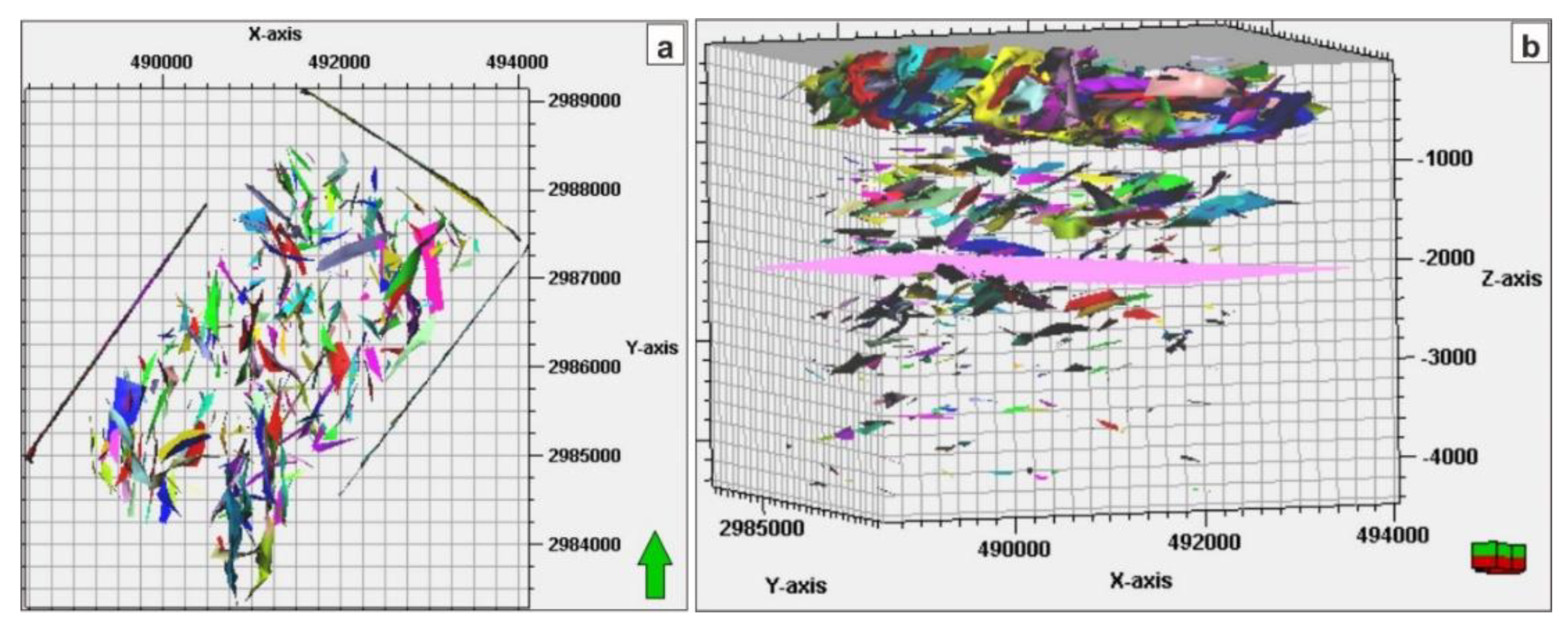
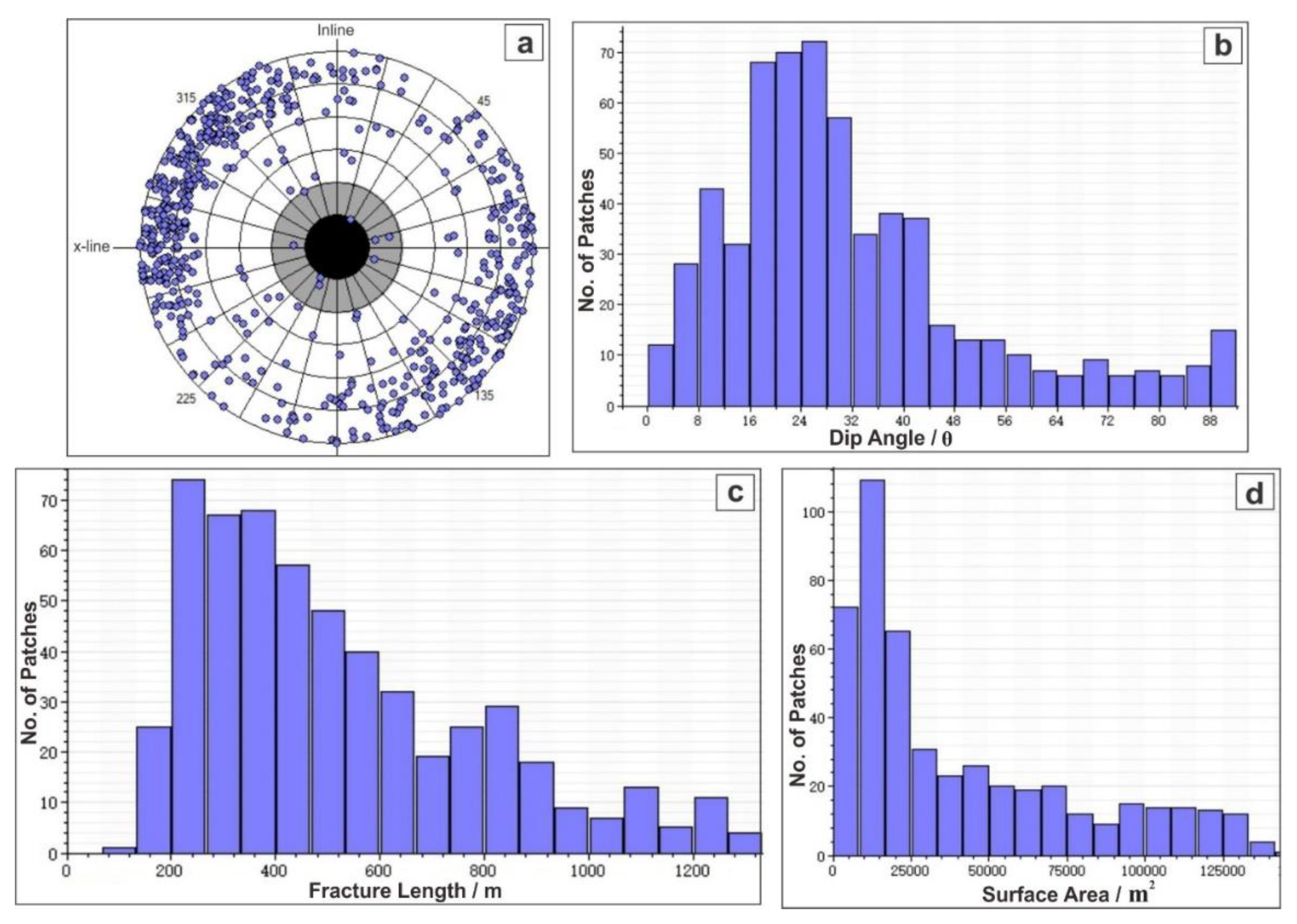

| Attributes | Relative Contribution |
|---|---|
| Polar-dip | 34.2 |
| Fault-enhancement Similarity | 31.9 |
| Thinned-fault likelihood | 95.4 |
| Maximum-curvature | 50.3 |
| Fracture-density | 100.0 |
| Fracture-proximity | 70.2 |
© 2020 by the authors. Licensee MDPI, Basel, Switzerland. This article is an open access article distributed under the terms and conditions of the Creative Commons Attribution (CC BY) license (http://creativecommons.org/licenses/by/4.0/).
Share and Cite
Ashraf, U.; Zhang, H.; Anees, A.; Nasir Mangi, H.; Ali, M.; Ullah, Z.; Zhang, X. Application of Unconventional Seismic Attributes and Unsupervised Machine Learning for the Identification of Fault and Fracture Network. Appl. Sci. 2020, 10, 3864. https://doi.org/10.3390/app10113864
Ashraf U, Zhang H, Anees A, Nasir Mangi H, Ali M, Ullah Z, Zhang X. Application of Unconventional Seismic Attributes and Unsupervised Machine Learning for the Identification of Fault and Fracture Network. Applied Sciences. 2020; 10(11):3864. https://doi.org/10.3390/app10113864
Chicago/Turabian StyleAshraf, Umar, Hucai Zhang, Aqsa Anees, Hassan Nasir Mangi, Muhammad Ali, Zaheen Ullah, and Xiaonan Zhang. 2020. "Application of Unconventional Seismic Attributes and Unsupervised Machine Learning for the Identification of Fault and Fracture Network" Applied Sciences 10, no. 11: 3864. https://doi.org/10.3390/app10113864






